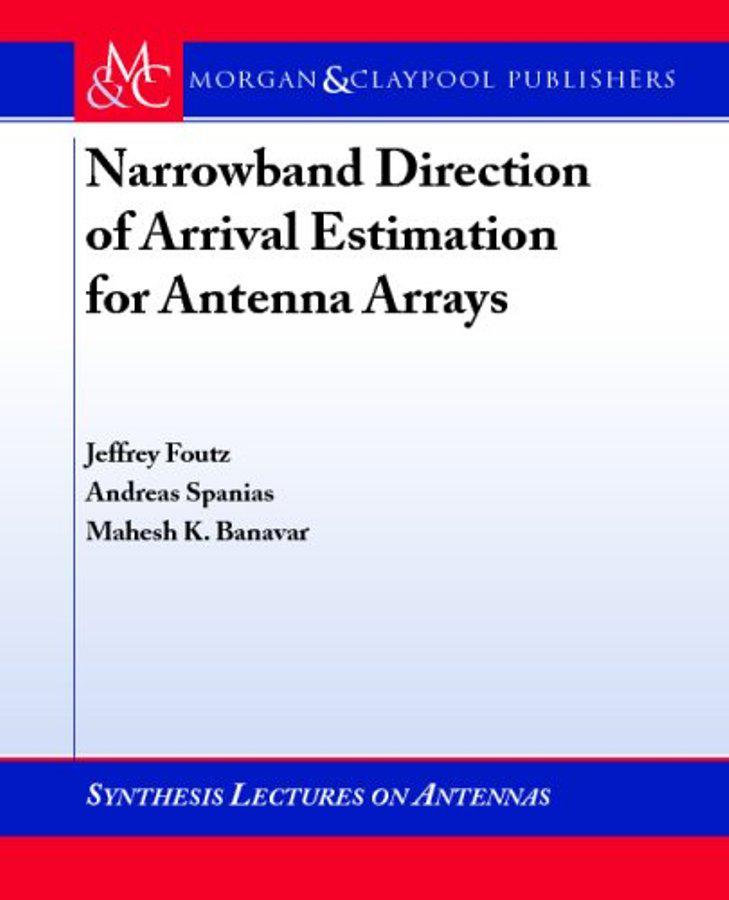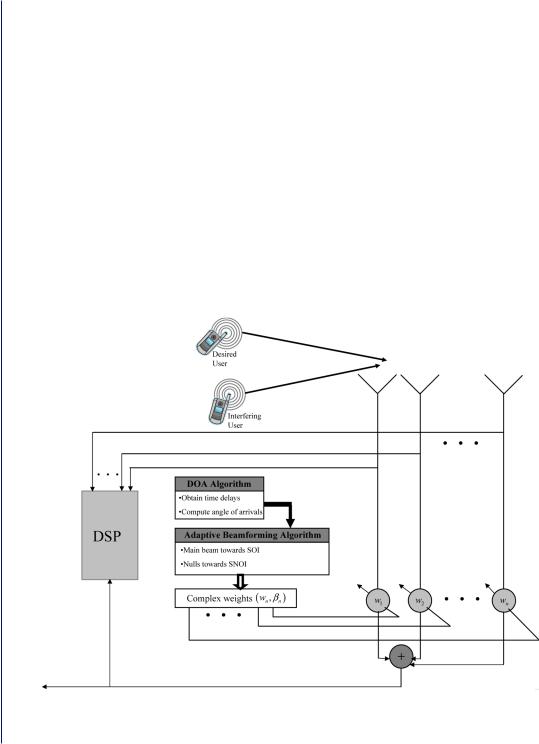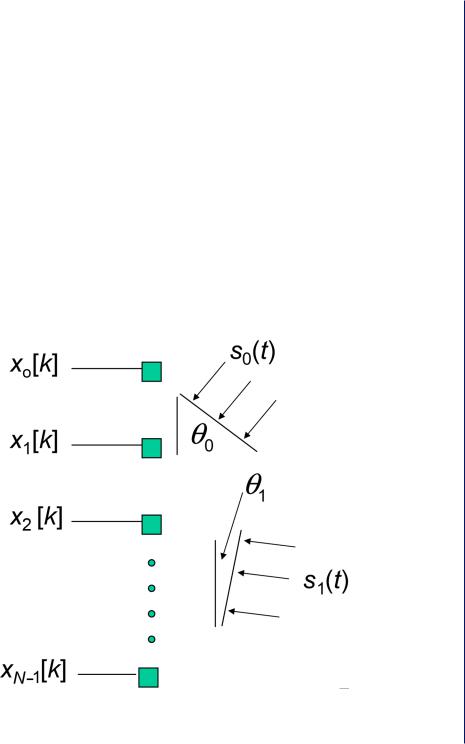
- •Abstract
- •Keywords
- •Contents
- •Introduction
- •Background on Array Processing
- •2.1 INTRODUCTION
- •2.1.1 Propagation Delays in Uniform Linear Arrays
- •2.1.2 Narrowband Approximation
- •2.1.3 Matrix Equation for Array Data
- •2.1.4 Eigenstructure of the Spatial Covariance Matrix
- •2.2 ANTENNA BEAMFORMING BASICS
- •2.2.1 The Conventional Beamformer
- •2.2.2 The Minimum Variance Distortionless Response Beamformer
- •3.1 CLASSICAL METHODS FOR DIRECTION OF ARRIVAL ESTIMATION
- •3.1.1 Delay-and-Sum Method
- •3.1.2 Capon’s Minimum Variance Distortionless Response Method
- •3.2 SUBSPACE METHODS FOR DOA ESTIMATION
- •3.2.1 Multiple Signal Classification Algorithm
- •3.2.2 Orthogonal Vector Methods
- •3.2.3 The Root MUSIC Algorithm
- •3.2.4 The Minimum Norm Method
- •3.2.5 Estimation of Signal Parameters via Rotational Invariance Techniques
- •3.2.6 Linear Prediction
- •3.2.7 The Unitary ESPRIT for Linear Arrays
- •3.2.8 QR ESPRIT
- •3.2.9 Beamspace DOA Estimation
- •3.2.10 The DFT Beamspace ESPRIT
- •3.2.11 The Multiple Invariance ESPRIT
- •3.2.12 Unitary ESPRIT for Planar Arrays
- •3.2.13 Maximum Likelihood Methods
- •3.2.13.1 The Alternating Projection Algorithm for ML DOA Estimation
- •4.1 ADAPTIVE SIMULATION EXAMPLE
- •Appendix
- •Signal Generator
- •The MUSIC Algorithm
- •The ESPRIT Algorithm
- •MVDR Method and the Classical Beamformer
- •Code to Simulate the MUSIC, the ESPRIT, the MVDR, the Min-Norm, and the Classical DOA Algorithms
- •References
- •Additional References
- •List of Symbols
- •List of Acronyms
- •Author Biography


Narrowband Direction of Arrival Estimation for Antenna Arrays

Copyright © 2008 by Morgan & Claypool
All rights reserved. No part of this publication may be reproduced, stored in a retrieval system, or transmitted in any form or by any means—electronic, mechanical, photocopy, recording, or any other except for brief quotations in printed reviews, without the prior permission of the publisher.
Narrowband Direction of Arrival Estimation for Antenna Arrays
Jeffrey Foutz, Andreas Spanias, and Mahesh K. Banavar
www.morganclaypool.com
ISBN: 9781598296501 paperback
ISBN: 9781598296518 ebook
DOI: 10.2200/S00118ED1V01Y200805ANT008
A Publication in the Morgan & Claypool Publishers series
SYNTHESIS LECTURES ON ANTENNAS #8
Lecture #8
Series Editor: Constantine A. Balanis, Arizona State University
Series ISSN |
|
ISSN 1932-6076 |
|
ISSN 1932-6084 |
electronic |

Narrowband Direction of
Arrival Estimation for Antenna Arrays
Jeffrey Foutz, Andreas Spanias, and Mahesh K. Banavar
Arizona State University
SYNTHESIS LECTURES ON ANTENNAS #8

iv
Abstract
This book provides an introduction to narrowband array signal processing, classical and subspacebased direction of arrival (DOA) estimation with an extensive discussion on adaptive direction of arrival algorithms. The book begins with a presentation of the basic theory, equations, and data models of narrowband arrays. It then discusses basic beamforming methods and describes how they relate to DOA estimation. Several of the most common classical and subspace-based direction of arrival methods are discussed. The book concludes with an introduction to subspace tracking and shows how subspace tracking algorithms can be used to form an adaptive DOA estimator. Simulation software and additional bibliography are given at the end of the book.
Keywords
smart antennas, array processing, adaptive antennas, direction of arrival, DSP

Contents
1. |
Introduction |
........................................................................................................ |
1 |
|
2. |
Background on Array Processing.......................................................................... |
5 |
||
|
2.1 |
Introduction......................................................................................................... |
5 |
|
|
|
2.1.1 ......................................... |
Propagation Delays in Uniform Linear Arrays |
5 |
|
|
2.1.2 .................................................................... |
Narrowband Approximation |
6 |
|
|
2.1.3 .............................................................. |
Matrix Equation for Array Data |
7 |
|
|
2.1.4 ..................................... |
Eigenstructure of the Spatial Covariance Matrix |
8 |
|
2.2 |
Antenna ............................................................................Beamforming Basics |
10 |
|
|
|
2.2.1 ............................................................. |
The Conventional Beamformer |
13 |
|
|
2.2.2 ............. |
The Minimum Variance Distortionless Response Beamformer |
15 |
3. |
Nonadaptive ......................................................Direction of Arrival Estimation |
17 |
||
|
3.1 Classical ......................................Methods for Direction of Arrival Estimation |
17 |
||
|
|
3.1.1 ........................................................................ |
Delay - and - Sum Method |
17 |
|
|
3.1.2 .............. |
Capon’s Minimum Variance Distortionless Response Method |
18 |
|
3.2 Subspace ...........................................................Methods for DOA Estimation |
20 |
||
|
|
3.2.1 .............................................. |
Multiple Signal Classification Algorithm |
20 |
|
|
3.2.2 .................................................................. |
Orthogonal Vector Methods |
22 |
|
|
3.2.3 ................................................................ |
The Root MUSIC Algorithm |
24 |
|
|
3.2.4 ............................................................... |
The Minimum Norm Method |
25 |
|
|
3.2.5 |
Estimation of Signal Parameters via Rotational |
|
|
|
............................................................................ |
Invariance Techniques |
28 |
|
|
3.2.6 ................................................................................... |
Linear Prediction |
30 |
|
|
3.2.7 ................................................ |
The Unitary ESPRIT for Linear Arrays |
32 |
|
|
3.2.8 .......................................................................................... |
QR ESPRIT |
36 |
|
|
3.2.9 ................................................................. |
Beamspace DOA Estimation |
37 |
|
|
3.2.10 ............................................................. |
The DFT Beamspace ESPRIT |
38 |
|
|
3.2.11 ......................................................... |
The Multiple Invariance ESPRIT |
40 |
|
|
3.2.12 ........................................................ |
Unitary ESPRIT for Planar Arrays |
42 |

vi NARROWBAND DIRECTION OF ARRIVAL ESTIMATION FOR ANTENNA ARRAYS
|
3.2.13 Maximum Likelihood Methods............................................................. |
45 |
|
3.2.13.1 The Alternating Projection Algorithm for ML |
|
|
DOA Estimation................................................................. |
46 |
4. |
Adaptive Direction of Arrival Estimation............................................................ |
49 |
|
4.1 Adaptive Simulation Example............................................................................ |
54 |
Appendix.................................................................................................................... |
55 |
|
References.................................................................................................................. |
59 |
|
Additional References................................................................................................. |
63 |
|
List of Symbols........................................................................................................... |
71 |
|
List of Acronyms......................................................................................................... |
73 |
|
Author Biography....................................................................................................... |
75 |
|

c h a p t e r 1
Introduction
Propagating fields are often measured by an array of sensors. A sensor array consists of a number of transducers or sensors arranged in a particular configuration. Each transducer converts a mechanical vibration or an electromagnetic wave into a voltage. Acoustic waves occur in microphone or sonar array applications. Mechanical waves are associated with seismic exploration and electromagnetic waves are used in wireless communications. Array signal processing applications include radar, sonar, seismic event prediction, microphone sensors, and wireless communication systems [1].
In engineering applications, where an incoming wave is detected and/or measured by an array, the associated signals at different points in space can be processed to extract various types of information including their direction of arrival (DOA). Algorithms for estimating the DOA in antenna arrays are often used in wireless communications to increase the capacity and throughput of a network. In this book, the focus will be on antenna arrays that receive or transmit electromagnetic
Figure 1.1: Antenna array and direction of arrival algorithms.

NARROWBAND DIRECTION OF ARRIVAL ESTIMATION FOR ANTENNA ARRAYS
waves in a digital communication network. Although most of the algorithms presented will focus on radio frequencies, we note that many of the discussed concepts can also be applied to mechanical and acoustic waves. We also note that the array processing algorithms presented can be used for real-time or offline applications.
DOA methods can be used to design and adapt the directivity of array antennas as shown in Figure 1.1. For example, an antenna array can be designed to detect the number of incoming signals and accept signals from certain directions only, while rejecting signals that are declared as interference. This spatiotemporal estimation and filtering capability can be exploited for multiplexing cochannel users and rejecting harmful co-channel interference that may occur because of jamming or multipath effects (Figure 1.2).
DOA algorithms can be divided into three basic categories, namely, classical, subspace methods, and maximum likelihood (ML) techniques [15]. In this book, the most important methods in each of these three categories will be discussed. The ML method offers high performance but
Figure 1.2: Antenna array used to spatially filter interference.

introduction
is computationally expensive. The subspace methods also perform well and have several computationally efficient variants. The classical methods are conceptually simple but offer modest or poor performance while requiring a relatively large number of computations. Note that these algorithms are initially presented under the assumption that the signal sources are stationary in space and that the incoming signals are not correlated (no signals present due to multipath propagation). At the end of the book, adaptive DOA estimation is discussed for the case where the directions of arrival are changing with time.
Classical methods covered in this book include the delay-and-sum method and the Minimum Variance Distortionless Response (MVDR) method. The subspace methods described include different versions of the Multiple Signal Classification (MUSIC) algorithm and the Estimation of Signal Parameters via Rotational Invariance Technique (ESPRIT). Among the ML techniques, the focus will be on the alternating projection algorithm (APA). The algorithms can operate with a variety of array geometries including uniform linear array (Figure 1.3) and the uniform planar array (Figure 1.4). Most or all the algorithms presented work with the uniform linear array. For the
Figure 1.3: A uniform linear array.

NARROWBAND DIRECTION OF ARRIVAL ESTIMATION FOR ANTENNA ARRAYS
Figure 1.4: Illustration of a 4 × 4 uniform planar array.
uniform planar array, one can use the MUSIC or the 2D ESPRIT algorithms, whereas for semispherical arrays the MUSIC algorithm may be appropriate.
The book organization is as follows. In the second chapter, we provide background information on propagation delays of an electromagnetic signal across an array; the signal model is established based on a narrowband digitally modulated signal. The covariance matrix and its eigenstructure are described in detail. In Chapter 3, we describe classical DOA methods and highresolution subspace methods. Finally, Chapter 4 covers adaptive DOA estimation and provides simulation examples. MATLAB software realizations of some of the algorithms are provided in the Appendix.
• • • •
